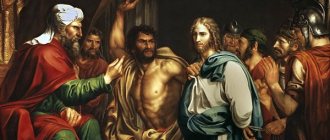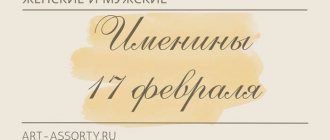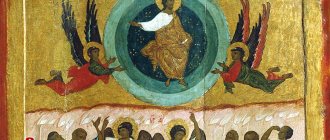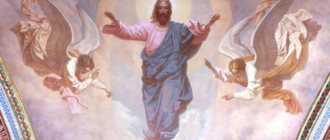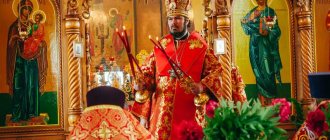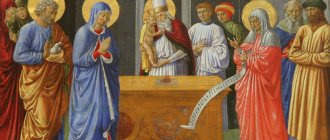What is Good Friday
In Orthodoxy, Good Friday is the most terrible day. The history of the origin of the holiday is told in the Gospel. After Judas' betrayal, Jesus was accused of inciting a riot. Christ was crucified at 9 am (according to Jewish clocks - at 3 pm), and the Savior died closer to Friday evening. The body of the Son of God was taken down from the cross and buried in a cave by the Apostles.
This Friday is called “Holy” because this day was filled with the passions (sufferings) of Jesus Christ. This was the last day of the Lord's human life. There are also other names: Holy Friday, Good Friday, Great Friday, Fridays, Red Friday.
The symbol of the holiday is the shroud - this is a cloth with an image of the icon of Jesus Christ in the tomb.
What date is Holy Week 2022
Holy Week 2022 directly depends on the date of Easter, just like the Orthodox holiday of Trinity. In 2022, Easter will fall on April 28. Exactly one week from April 21, 2022, Holy Great Week begins.
From Sunday, April 21, you should refrain from noisy celebrations, scandals, and bad deeds. Starting from Maundy Monday and in the subsequent days of Holy Week, it is customary to pray and do good deeds. If a birthday or other festive event occurs during Lent, it is better to postpone it and celebrate it after Great Sunday. However, many Orthodox believe that the dates that coincide with Lent are special and, on the contrary, strive to celebrate the memorable event as magnificently as possible.
Celebration traditions
On the fifth day of the week, the church holds three services. Matins takes place on the night from Thursday to Friday. The Gospel about the Passion of the Lord is read on it. During the day the “Royal Clock” is used. The last one is Vespers, where the shroud decorated with flowers is brought out.
The shroud is buried at the end of the day at Matins on Holy Saturday. There is no Divine Liturgy on Good Friday.
After the burial, a small vespers is held, at which hymns are sung about the lamentation of the Most Holy Theotokos on Good Friday, as well as a canon about the crucifixion of Jesus Christ.
All preparations for Easter should be completed on Maundy Thursday, but sometimes housewives do not have time to prepare holiday cakes and do it on Good Friday. Before you start kneading dough for them, you need to receive a blessing. To do this, read the “Our Father” prayer, after which you need to cook in peace and quiet.
In Rus', it was customary to observe both church and pagan traditions. For example, the custom of lighting fires and calling on God Perun to protect the harvest from the effects of natural elements. Our ancestors considered this time the most favorable for sowing.
On the day of celebration for the Orthodox, certain rules and prohibitions come into force. This is also the strictest day of Lent. The first meal should not be earlier than three o'clock in the afternoon, since this is the time when the ceremony of removing the shroud ends.
What not to do on Good Friday
- On this holy holiday, you cannot clean or wash clothes.
- You can't wash or swim.
- Any work around the house or in the garden is prohibited.
- Do not use rakes, pitchforks or shovels.
- You cannot be angry, offended, swear or swear.
- Drinking alcohol is strictly prohibited
- You can't have fun.
- Cut and dye hair.
- It is not recommended to bake Easter cakes and paint Easter eggs.
- You cannot indulge in carnal pleasures.
- You can't go to the cemetery. (Exception: funeral)
- It is not customary to heat the bathhouse on Good Friday.
What can you do
- On this day, you must definitely visit the temple and pray.
- The day should pass in peace and quiet, without feasts and festivities.
- We need to help those in need.
- Do good, godly deeds.
- Forgive all offenders and ask for forgiveness yourself.
- You can visit a person you haven’t seen for a long time.
- Thank the Lord for suffering.
- You can be sad and cry.
What can you eat on Good Friday?
On Fridays you cannot eat until the end of the second service. Afterwards they eat bread and drink water. You can also have fruits and vegetables. All animal products and alcoholic beverages are strictly prohibited. No food is prepared. Sick and pregnant women do not have to fast.
How to take communion during Holy Week
Communion helps to cleanse the soul, strengthen one’s consciousness, and not become embittered. The righteous path gives a person a chance to enter the Kingdom of God, which opens the way to heaven. If during Bright Week, immediately after Holy Week, you can take communion every day, then during Holy Week it is considered better to abstain from communion. The soul of the Lord suffered in the last week of earthly life, and during the hours of Holy Week it is better to pray, empathizing with Jesus Christ, than to repent of one’s sins.
Holy Week involves modest food, quiet conversations, righteous behavior with thoughts of God. This week you need to prepare for Bright Week in order to receive communion. The laity should come to an understanding of the sins they have committed, but if there is a desire to get rid of mental burden during Holy Week, then there is no point in waiting. The Church does not prohibit communion on Holy Week.
What prayers to read on Good Friday at home
Prayers you can read at home:
Akathist to the Passion of Christ
Kontakion 1
Chosen by the Voivode and Lord of Heaven and earth, You, the Immortal King, hanging on the Cross, all creation changed, the sky was terrified, the foundations of the earth were shaken. But we, who are unworthy, bring Thy grateful worship to us for the sake of suffering, crying out to Thee with the thief: Jesus, Son of God, remember us when Thou comest in Thy Kingdom.
Ikos 1
Replenishing the angels of the ranks, you did not receive from the Angel, but for my sake, this God, having become a man, having died in sins with your life-giving Body and revived by Your Blood; In the same way, give thanks to the capital of Your love, crying out to You:
Jesus God, Eternal Love, has been pleased with us earth-born creatures; Jesus, immeasurable mercy, descended to fallen people. Jesus, who clothed himself in our flesh, and by His death destroyed the empire; Jesus, you deify us with Your Divine Mysteries. Jesus, through Your suffering and Your Cross you have redeemed the whole world; Jesus, Son of God, remember us when You come into Your Kingdom.
Kontakion 2
Seeing Thee in the helitown of Gethsemane, sweating bloodily in prayer, appearing to strengthen Thee, when the heavy burden of our sins weighed down on You: for you, Adam who perished on the frame, You presented to the Father, kneeling in prayer. For this reason I sing to You with faith and love: Alleluia.
Ikos 2
A mind that cannot comprehend Your free suffering did not understand the Jews: for this reason, always in the night with the lamps you proclaimed to those who were looking for You: I am, even though I had fallen to the earth, but for this reason I bound You, leading you to the judgment; We, on this path, falling to You, call with love:
Jesus, Light of the world, hated by the evil world; Jesus, living in the Unapproachable Light, removed from the region of darkness. Jesus, the Immortal Son of God, designated from the son of destruction to death; Jesus, in Him there is no flattery, kissed by the traitor with flattery. Jesus, give Yourself tuna to everyone, sold for pieces of silver; Jesus, Son of God, remember us when You come into Your Kingdom.
Kontakion 3
By the power of Your Divinity, You prophesied threefold rejection of the disciple. Therefore, even if he had renounced You with an oath, he, however, when he saw You in the courtyard of the bishops, his Lord and Teacher, was touched in his heart, and went out crying bitterly: “Look then upon me, Lord, and strike my cruel heart, and with your tears with mine I will wash away my sins, singing to You: Alleluia.”
Ikos 3
Truly have power according to the order of Melchizedek, as a Bishop forever, you have become before the lawless high priest Caiaphas, Lord and Lord of all; Having suffered torment from Your servants, accept from us the following:
Jesus, priceless, purchased with a price, gain me for Your eternal inheritance; Jesus, the desire of all, from Peter, outcast for fear, do not reject me, a sinner. Jesus, gentle Lamb, tormented by fierce boars, rescue me from my enemies; Jesus, Bishop, who entered the Holy of Holies with Your Blood, cleanse me from the defilements of the flesh. Jesus, bound, have the power to bind and decide, resolve my grave sins; Jesus, Son of God, remember us when You come into Your Kingdom.
Kontakion 4
The Jews breathing a storm of Christ-killing, having listened to the voice of the father of lies and murderer from time immemorial, the devil, rejected You, the right Path, Truth and Life; We are Thee, Christ, the power of God, in Him all the treasures of wisdom and reason are hidden, confessing, crying out: Alleluia.
Ikos 4
Hearing Your meek words, Pilate, like one worthy of death, delivered You up to be crucified, even though you yourself testified that you have not found a single guilt in You: defile your mind with your hands, but defile your heart; We, marveling at the mystery of Your free suffering, call with tenderness:
Jesus, Son of God and Son of the Virgin, martyred from the sons of iniquity; Jesus, mocked and naked, give glory to the villages and clothe the sky with clouds. Jesus, full of stripes, fed five thousand with five loaves; Jesus, the King of all, received cruel torment instead of tribute to love and thanksgiving. Jesus, for our sake you have been wounded all day, heal the wounds of our souls; Jesus, Son of God, remember us when You come into Your Kingdom.
"Our Father"
Our Father who art in heaven! Hallowed be Thy name; Thy kingdom come; Thy will be done on earth as it is in heaven; Give us this day our daily bread; And forgive us our debts, as we forgive our debtors; And do not lead us into temptation, but deliver us from evil. For Yours is the kingdom and the power and the glory forever. Amen.
Troparion of the Great Heel
To this day hangs on the Tree He who hung the earth on the waters; the King of Angels is crowned with a crown of thorns; Clothes the sky with clouds in clownish purple; The one who freed Adam in the Jordan receives slaps; the Bridegroom of the Church is nailed; The Son of the Virgin is pierced by a spear. We worship Your suffering, O Christ. We worship Your suffering, O Christ. We worship Your suffering, O Christ. Show us Your all-glorious Resurrection!
Let us not celebrate like the Jews: for our Passover, Christ God, was sacrificed for us; but let us cleanse ourselves from all filth, and sincerely pray to Him: “Rise up, Lord, save us, as a Lover of mankind!” Thy Cross, O Lord, is life and resurrection for Thy people; and trusting in him, we sing praises to You, our crucified God, have mercy on us.
Baptism on Holy Week
Passion Week is a time of mourning over the torment of Christ. On the Great Days of the Week, it is not customary to serve a feast or celebrate festivities; this week it is better to refrain from festive events. There is only one such week a year and entertainment programs can wait. It would be better to postpone the baptism to the next Bright Week. Immediately after Easter come the days of joy when Christ is resurrected.
During Holy Week the church is busy, the laity go to services, confess, and receive communion. But if a special case of baptism arises, the child is weak or sick, then the priest can go to the meeting. There is no prohibition in the church charter from baptism during Holy Week. It is better to agree on all matters with the rector and choose a time for christening.
Signs
Folk signs:
- Whatever is planted on this day will not bear fruit. You can only plant parsley and cabbage.
- To be born on a holiday means a difficult fate.
- To give birth is to bring trouble to the baby and yourself.
- If you laugh and have fun on this day, you will have to cry all year.
- Children who were conceived on the day of the holiday are doomed to misfortune.
- Those who die on Red Friday receive God's grace.
- People born on this day cannot celebrate their birthday.
Weather signs:
- If many stars are visible in the sky, then wheat will be born.
- Sunny weather means a large harvest of bread.
- Rainy weather means cold spring.
Signs for unmarried girls:
- There is an insect in the food - see you soon.
- Seeing a bird outside the window means meeting a man.
- If your lip itches, go for kisses.
- If your eyebrow itches, you’ll soon meet your betrothed.
- If you leave one shelf in your closet empty on the eve of a holiday, it means inviting a man into your home.
- A girl hits her elbow, which means her betrothed is thinking about her.
Signs for health:
- Digging the ground on the day of the holiday means serious illness.
- If you bake bread in the shape of a cross, it will become a talisman.
- A ring consecrated in the church on the day of the holiday will serve as a talisman.
- If you bake bread on Good Friday, it will acquire medicinal properties.
- If you get sick on the day of the holiday, it means there will be a quick recovery.
Dream from Maundy Thursday to Good Friday
It is believed that truly prophetic dreams occur on the night of Good Friday. There is an opinion among people that on this day dreams are filled with special content. There are also those who are convinced that on all the nights of the festive week they dream of something that will definitely come true.
The meaning of dreams on Good Friday before Easter:
Dreams this night are divided into 3 groups:
- the events of the past day are repeated in a dream;
- prophetic visions;
- dreams sent by demons.
Believers claim that dreams that were dreamed on Friday night will come true during the first half of the day or within a year. It is only important to interpret them correctly. Dreams from the first group do not have any supernatural meaning. Those that are commonly called “demonic” require special attention. They cause the most anxiety and fear. But there is nothing to worry about here, no dark entities are trying to take over a person. The appearance of something unpleasant in a dream may mean that someone from above is trying to warn the sleeping person about something. There is no need to concentrate on the bad, because “demonic” dreams are harbingers of good events and news.
Don't ignore what you dream about on the eve of the holiday. These dreams contain hidden signs and clues that can predict the near future and even help prevent impending disaster.
Confession on Holy Week
Confession during Holy Week, like communion, is not prohibited by anyone. Parishioners should only take into account the fact that clergy devote most of their time to the service with the canons on Great Week and they simply do not have time to engage in individual confessions. For this procedure, it is better to choose Maundy Monday, Tuesday or Wednesday.
In the first three days of Holy Week there are still few people in the church; the priest can listen to the laity, read a prayer over them, and cross them. On Maundy Thursday, general confession is held, but if the soul needs to open up and repent, then it is better to choose freer days.
Questions and answers
| Is it possible to take a bath on Good Friday? |
| It is recommended to take water procedures and clean the day before the holiday - Maundy Thursday. You can't do this on Good Friday. |
| Is it possible to dye eggs on the day of the holiday? And is it possible to bake Easter? |
| Anything, including preparing for Easter, should be abandoned today. |
| When is the shroud taken out? |
| The Shroud is taken out at Great Vespers at 3 pm and then the cycle of services is considered completed. |
| Is it possible to work? |
| There is no specific ban on work on this day. But even in the workplace, it is necessary to devote the whole day to the memory of Jesus the Savior. |
| Is it good to die on Good Friday or not? |
| death during the festival is not a good or bad sign. There is no guarantee that a soul will definitely go to heaven or hell. It is popularly believed that if death occurs during the week of Holy Week, this means that the deceased received God's blessing. |
What date is Holy Week 2022
Holy Week is usually called the 7 days preceding Great Easter. Moreover, all days bear the prefix “Great”, Maundy Monday, Maundy Tuesday, etc. In 2022, Easter falls on April 8 (04/08/2018). This means that you need to count 7 days ago from this date. That is, it turns out that Holy Week begins on Sunday, April 1st. Yes, yes, exactly on Sunday. In fact, this is Palm Sunday and it does not belong to Holy Week, but from the evening of this day you need to prepare for Holy Week. In fact, the Week consists of 6 Strict days; there is no Sunday in it.
Maundy Tuesday
MORNING: Clock. Fine. Vespers. Liturgy of the Presanctified Gifts
In 2015 in the morning: Clock. Fine. Vespers. Liturgy of St. John Chrysostom
EVENING: Matins. 1st hour
The general pattern of Holy Tuesday is the same as on Monday. Tuesday's texts are dedicated to the teachings of the Savior, which he delivered in the Temple on the second day after His triumphal entry into Jerusalem. The main place is occupied by the topic of denunciation of the Pharisees and scribes, who after this finally break with Christ and decide to kill Him. Particular attention is drawn to the parables of the ten virgins and the talents. They warn Christians about the enormous responsibility for every action in life and about the cause-and-effect relationship in a person’s life.
Old Testament texts continue to tell about the suffering of the Jewish people in Egyptian captivity and about the righteous Job. They all say that grief is not in vain, and prepare believers for worthy participation in the Passion of the Lord.
The twelfth feast of the Annunciation falls on Holy Tuesday 2015. In connection with it, in the morning it is not the Presanctified Liturgy that is served, but the Liturgy of St. John Chrysostom.
Unction on Holy Week
Unction or consecration of oil comes from the apostolic times of Jesus Christ. The procedure of anointing the body with sacred oil is carried out to cleanse the soul and body. This is a rather complex ritual; it is performed only on Orthodox Christians over 7 years of age. 7 clergy take part in the ritual. 7 is a symbolic number, according to church rules, it means a cathedral - 7 priests. Before anointing a layman, 7 excerpts from the Apostle and the Gospel are read. They talk about mercy, spiritual and physical healing, repentance, and faith.
Unction can be performed during Lent during Holy Week. In this matter, the main thing is that the clergyman finds time for such a serious ritual. It is performed on both healthy and sick believers. Sacred oil can heal mental and physical wounds. It is believed that illnesses are sent to a person because of his sins, and in order to be healed from them, one must be cleansed spiritually.
It is possible that Holy Week is just the time when a person comes to the idea that he needs to cleanse his soul from sin. The church does not prescribe any special rules regarding unction. The abbots recommend confession and communion before the procedure, and unction afterward. You can do the opposite, choose a day for unction during Holy Week, agreeing on it with the clergyman, and then confess and receive communion.
Text of the book “Liturgical Rules and Hymnography”
Topic 5. Divine service of Holy Week
Holy Week is a very special part of the church year.
In ancient times it was called “Easter of the Cross” or “Easter of Suffering”. It is also called “Great” because of the greatness of the events that took place there and because of their significance for the entire human race. This time is entirely devoted to the remembrance of the saving Passion of Christ; during Passion, the memory of saints and the remembrance of the departed are not celebrated, and church holidays are postponed to another time. The service of Holy Week differs significantly from the usual with a number of special sacred rites and sublime spiritual chants. In it, all the Old Testament predictions and prototypes, all the New Testament narratives about the last days of the earthly life of the God-man are collected into a single, integral and majestic image.
Each of the days of Holy Week has its own special memories and the content of liturgical chants and readings in accordance with them.
5.1. Holy Monday, Tuesday and Wednesday
On Maundy Monday
I remember the beautiful
Joseph
, who, out of envy, was sold by his brothers to Egypt, suffered and then became famous.
This is a prototype of Christ, betrayed by his compatriots to suffering and death. On this day, we also remember the Lord’s curse on the barren fig tree
- a prototype of the hypocritical Pharisees, who, despite their outward piety, did not have the true fruits of faith. The Synaxarion of Holy Monday explains that the fig tree is likened and “every soul, of every spiritual fruit, is not involved.”
On Maundy Tuesday
I remember the accusatory parables and conversations of the Lord, spoken by Him on this day in the Jerusalem temple:
about ten virgins, about talents, about the end of the world and the Last Judgment
.
On Great Wednesday
I remember
the sinful wife who anointed the Lord with myrrh
in Bethany in the house of Simon the leper and
the betrayal of Judas
. The hymns more than once compare the act of the repentant harlot with the betrayal of the disciple.
From the point of view of the statutory provisions and the general content of the service, these first three days are usually considered as something unified.
Services on Holy Monday, Tuesday and Wednesday follow the same pattern and retain their penitential Lenten character.
At the beginning of Matins
after
“Alleluia”
the famous troparion is sung three times:
“Behold the Bridegroom comes at midnight”
“inertly [slowly] and loudly [loudly, in a full voice], and with sweet singing [beautiful melody and evenly].”
The Gospel is read, containing a narrative about the deeds and speeches of the Lord in the last days of His earthly life, His parables and conversations about the end of the world and the second coming[129] 129 Averky (Taushev), Archbishop.
Decree. op. P. 167.
[Close].
Instead of the whole canon, only the three-canon is placed (on Holy Tuesday - the two-canon).
After its completion, three times, “inertly and with sweet singing,” the exapostilary is sung: “I see Your palace, my Savior, adorned, and I am not imam, but I will enter into it: enlighten the robe of my soul, O Light-Giver, and save me.”
It is supposed to be sung from Maundy Monday to Maundy Thursday, 12 times in four days.
Of course, this is not accidental. This exapostilary is one of the most important texts of Holy Week. It is compiled from the 1st person, on behalf of each of us. This prayer is for the purification of our soul, for the granting of bright robes to it, without which it is impossible to enter the Heavenly palace (Matthew 22:2–14) [130] 130 Krasovitskaya M. S.
Decree. op. P. 154.
[Close].
The Doxology is read, and the end of Matins is Lenten.
Lenten hours are celebrated
3rd, 6th and 9th with
figurative ones
and then
the Liturgy of the Presanctified Gifts
.
The main feature of the watch
in the first three days of Holy Week is that
the entire Four Gospels are read
.
The Gospels of Matthew and Mark are read each in two parts, the Gospel of Luke - in three parts. The Gospel of John is read in two parts, but not completely, but only up to the words: “Now is the Son of Man glorified
...
”
(John 13:31), that is, before the beginning of the Lord’s farewell conversation with the disciples. Thus, over the course of three days, there is one reading at each of the three hours (3, 6, and 9), for a total of nine readings.
Another feature of the first three days of Holy Week is the change of proverbs. The entire fast, the proverbs of Vespers were taken from the books of Genesis and Proverbs of Solomon, and the proverbs of the sixth hour were taken from the book of the prophet Isaiah. Now at the sixth hour the prophecy of Ezekiel
, and at Vespers - the books
of Exodus
and
Job
. The book of Exodus tells about the disasters of the Jews in Egypt and deliverance from them, about the path to the Promised Land. This is a prototype of the liberation of humanity from sinful captivity. The uncomplaining suffering of righteous Job is a prototype of the saving passions of the Lord. The passage taken from the book of the prophet Ezekiel speaks of his call to prophetic ministry (chapters 1–2, beginning of chapter 3). The description of the majestic theophany to the Old Testament prophet is intended to remind us of the Divine dignity of Christ, whose utmost humiliation and suffering we remember during Holy Week. This opposition of Divine greatness and exhaustion is a characteristic feature of the hymnography of Holy Week.
The first three days of Passion Week have the same dismissal: “Christ our true God came to our free passion for the sake of salvation...”
On Great Wednesday, the Liturgy of the Presanctified Gifts is served for the last time, and the prayer of St. Ephraim the Syrian, prostrations are made for the last time[131] 131
They will be performed only in front of the Holy Shroud.
[Close], the Psalter will be sung for the last time - everything characteristic of the Lenten service will end. Before the Liturgy of Wednesday, the Typikon appoints a rite of forgiveness for the entire fast, similar to that performed on Forgiveness Sunday. The environment is like a boundary separating one type of worship from another. After Wednesday, very special services begin, dedicated to the saving Passion of the Lord[132] 132
Krasovitskaya M.S.
Decree. op. P. 249.
[Close].
5.2. Maundy Thursday
On Maundy Thursday, several important events are remembered:
• The Last Supper, at which the Sacrament of the Eucharist was established;
• Washing the disciples' feet;
• Gethsemane prayer;
• The theme of Judas' betrayal continues to develop.
At Matins after Alleluia
The well-known troparion of Maundy Thursday is sung three times:
“When the glorious disciple at the washing of the supper
[washing the feet]
is enlightened, then the evil Judas, sickened by the love of money, is darkened, and betrays You, the Righteous Judge, to the lawless judges.
Look, wealth stewards [Look, collector of wealth], [at the one who]
for these sake used strangulation
[hanged himself]!
Flee the insatiable soul
[the insatiable soul]
, the Teacher who
to [make]
thing.
For all good things, Lord, Glory to Thee .
In this text we find not only a description of the events recalled, but also an appeal to the soul of each of us, although, it would seem, the time of repentance and self-deepening has already passed, and we must turn entirely to the events of the Savior’s life. All the brightest, most important prayers of Holy Week have this character. Along with the presentation of the Gospel events and their Old Testament prototypes, along with the depiction of the mystery of the redemption of the human race, a constant appeal to our heart and conscience is the most characteristic feature of the worship of this period [133] 133 Krasovitskaya M. S.
Decree. op. P. 252.
[Close].
The Gospel of Luke about the Last Supper (108th conception) and the canon of one of the best Orthodox hymnographers, St. Kosma Mayumsky († 787) “The Red Sea is cut.”
In this canon, the theme of establishing the Sacrament of the Eucharist is revealed through the Old Testament image of Wisdom calling everyone to a meal (Prov. 9:1-11, proverb for the feasts of the Mother of God):
“Initiating
into the sacraments
, he prepares a soul-nourishing meal, but Wisdom is truly immortal God dissolves the Cup to the faithful.
Let us approach piously and cry: “Gloriously is Christ our God glorified” (canto 1).
The second theme of the canon is the washing of the feet of the One who created “the lakes
[lakes]
and the springs of the sea”
(canto 2):
“The Lord shows the image of humility as a disciple, the clouds overlay the sky
[covering the sky with clouds]
, girds himself with ribbon, and bends his knees, the slave washes his feet , in His hand
[He in Whose hand]
is the breath of all things”
(song 5). And, of course, the canon continues the theme of the betrayal of Judas and the Lord’s final instructions to His disciples.
The exapostilary is the same as in the first three days of Holy Week: “Thy Chamber”
. It is sung for the last time. These words were heard three times at every morning for four days in a row, preparing us for the service of Maundy Thursday, for participation in the Last Supper.
At the end of Matins, after “There is Good”, the Trisagion
and
“Our Father”
the troparion of Maundy Thursday is sung for the second time:
“When the glory of the disciples ...”
At the first hour
a paremia is read from the book of the prophet Jeremiah (chap. 11:18–23, ch. 12:1–15) which describes the enmity of the Jewish elders against Christ and His meekness and gentleness with which He gives Himself into their hands[134]
134 Averky (Taushev), archbishop.
Decree. op. P. 168.
[Close].
Watch
The 3rd, 6th, and 9th are performed simply, without singing. These are the usual three-psalm hours.
They are joined by visual
, after which
the Liturgy of St.
Basil the Great , connected to Vespers.
The celebration of the Liturgy at Vespers on this day is due to the fact that the Sacrament of the Eucharist was established by the Lord in the evening. The Liturgy of Maundy Thursday is one of those Liturgies in which there is no Cherubic Song. Instead, on this day it is sung “Thy secret supper this day, O Son of God, receive me as a partaker: I will not tell the secret to Thy enemies, nor will I give thee a kiss like Judas, but like a thief I will confess thee;
remember me, Lord, in Your Kingdom .
These words are also sung instead of the sacrament, during the communion of the laity, and instead of: “Let our lips be filled with
...
"
As a celebrant at the Liturgy of St. Basil the Great, the chant “He rejoices in You”
.
But at this Liturgy there is another worthy, turning our minds to the greatness of the Sacrament of the Eucharist, to the immortal Meal prepared for us by the Savior. This is the irmos of the 9th song of the canon “The Cut”
“The Wanderings of the Lady”.
“Wanderings Lady and immortal Meals in a high place, high minds, faithful, come, let us enjoy, having ascended the Word, having learned from the Word, We magnify Him”
[135]
135
“Wanderings” is a treat for strangers, hospitality.
“The hospitality of the Lord and the immortal Meal in a high place, come, faithful ones, let us enjoy, directing our minds to the highest. We have learned this sublime word [teaching] from [the] Word Himself, Whom we magnify” [See: John (Maslov), schema-archim.
Decree.
op. P. 256; Krasovitskaya M. S.
Decree. op. P. 259].
[Close].
The Liturgy of Maundy Thursday has a special dispensation: “Who, for surpassing goodness, showed the kindest path of humility, who never washed his feet as a disciple, even to the Cross and burial, who condescended to us, Christ, our true God...”
, the Rite of Washing the Feet is performed in cathedrals on this day.
(it is described in the Great Trebnik).
The bishop goes out through the royal doors to the place of the clouds; in front of him one deacon carries the Gospel, two more deacons carry a basin and a washstand. The priests, sitting on the High Place, slowly read the 50th Psalm. The protodeacon brings 12 priests in pairs to the middle of the church while singing the 5th canon of Maundy Thursday. Everyone sits down, and sits all the time, even when reading the Gospel. The protodeacon pronounces the Great Litany with special petitions “To be blessed and sanctified by this mind...”
The protodeacon reads the Gospel of John about the washing of feet, during the reading of which the bishop does everything that is said in it about Jesus Christ, and washes the feet of all 12 priests, depicting the apostles.
The eldest of the priests portrays the Apostle Peter, and the bishop has a dialogue with him in the words of the Gospel. The bishop himself finishes reading the Gospel, in which the Lord explains the meaning of the washing he performed. In conclusion, he reads a prayer that the Lord will wash away all the filth and impurity of our souls[136] 136 Averky (Taushev), Archbishop.
Decree. op. pp. 168–169.
[Close].
On Maundy Thursday, Chrismation
and the consecration of the world (it is performed by the patriarch after the Great Entrance)[137]
137
Let us recall that St. Myrrh is used: in the sacrament of Confirmation, which is performed after Baptism, during the consecration of a new temple - it anoints the antimension, throne and walls, during the solemn wedding of kings to the kingdom.
[Close].
5.3. Good Friday
On Good Friday there are three main services: Matins
,
Royal Hours
and
Great Vespers
with Compline.
The Liturgy on this day is not celebrated due to deep sorrow and intense fasting in remembrance of the crucifixion and death of the Lord and out of special reverence for the Calvary Sacrifice, which was offered on this day. The only exception is when the Feast of the Annunciation falls on Good Friday. In this case, the Liturgy of St. John Chrysostom[138] 138 John (Maslov), schiarchim
.
Decree. op. P. 258; Averky (Taushev), archbishop
. Decree. op. P. 170.
[Close].
The night of Good Friday is supposed to be spent listening to the Gospels about the Passion of Christ, because it was on this night that the Lord was arrested, tried, tortured and abused. The narrative of the Passion of the Lord is presented in chronological order in 12 readings, selected from all 4 Evangelists. These readings are heard throughout the Matins of Good Friday
.
It takes place on Maundy Thursday in the evening (according to the Charter, it should begin at 2 am, that is, at 7 pm). This Matins has a special name: Following the holy and saving passion of our Lord Jesus Christ
.
The Gospel is brought to the middle of the temple after the Six Psalms, the Great Litany and Alleluia.
, when singing the troparion:
“When the glory of the disciples...”
At each reading of the Gospel, the bell is struck as many times as the Gospel is read. After reading the 12th Gospel, they strike 12 times, and then there is a short ringing of all the bells
.
Everyone listens to the reading of the Gospels with lit candles. Before each reading, “Glory to Thy Passion, Lord, Glory to Thee” is sung.
After each reading - “Glory to Your long-suffering, O Lord.” The Gospel readings are located between the Matins chants. The first 6 readings seem to replace kathismas. Between them three antiphons are sung, a small litany and sedalny are pronounced. These are the only saddle events during which you are not supposed to sit. "I'll eat while standing
[
them
]
,
” The last, 15th antiphon, “Today hangs on the tree,”
is the most solemn and significant.
This is a “hymn to Divine exhaustion.” He reminds us of the Greatness of God, “of the One who suffers” [139] 139 Krasovitskaya M. S.
Decree. op. P. 262.
[Close].
After the 6th Gospel, “Blessed” is sung with troparia and then, before the 7th Gospel, the Prokeimenon is pronounced : “Having divided My garments for myself, and cast lots for My clothing.”
.
Before the 8th Gospel, the 50th Psalm is read and the Three Song
St.
Kosma Maiumsky “
.
” In the eighth canto of this canon, St. Cosmas reveals the spiritual reasons for Peter's denial. Irmos of the 9th song of the canon is the most famous song in honor of the Most Holy Theotokos, “The Most Honest Cherub.” After the canon, the famous luminary sounds: “ Thou hast vouchsafed the prudent thief in one hour of heaven, O Lord, and enlightened me with the Tree of the Cross and saved me.”
After it the 9th Gospel is read.
The 10th Gospel is heard before the daily doxology, the 11th Gospel - after it. 12th Gospel - after the stichera on the stichera. This Matins is everyday in structure, and its ending is usual - “There is Good,” the Trisagion, “Our Father”
, troparion.
Moreover, a different troparion is sung, not the one that was sung at the beginning: “Thou hast redeemed us from the legal oath with Thy honest Blood, having been nailed to the Cross, and pierced with a spear, Thou hast extinguished immortality as a man, Our Savior, glory to Thee
. This troparion reveals the highest meaning of the Passion of Christ - redemption and the granting of immortality to the human race.
The dismissal of this service is connected with its content: “Who endured spitting and beating and strangulation, and the cross and death, Christ our true God...”
Good Friday Matins is described in detail in Appendix 6.
On the morning of Good Friday “about the second hour of the day,” that is, in our opinion, at 8 o’clock in the morning, the Royal Hours
.
At them there is the singing of special troparions, Old Testament prophecies about the Passion of Christ are read, apostolic readings and again the passionate Gospels. At the 1st hour there is the entire story of the Passion of Christ according to the Evangelist Matthew, at the 3rd hour - according to Mark, at the 6th hour - according to Luke and at the 9th hour - according to John. figurative exercises
. ”
Vespers
on this day it is usually performed in the middle of the day, around the time when the Savior died on the cross. Three proverbs are read on it. The first is from the book of Exodus, about Moses praying for the criminal Jewish people (Exodus 33:11–23). This is a prototype of Christ as the Intercessor for the entire human race, mired in sins. Second proverb from the book. Job (Job 42:12–17). It depicts the righteous Job, after extraordinary suffering, crowned with the mercies of God, a prototype of the Divine Sufferer. The third is from the book of the prophet Isaiah, nicknamed the “Old Testament Evangelist” for his surprisingly accurate prophecies about Christ. At Vespers, verses 52, 53 and 54 are read (52:13–54:1).
Then the Apostle, the letter of the Apostle Paul to the Corinthians (1 Cor. 1:18–2:2) and the special composite Gospel are read. It is called the 110th conception of the Gospel of Matthew, but lines from other Gospels are inserted into it so that the narrative of the Passion, Death on the Cross and burial of the Savior is as detailed and complete as possible.
Then, in accordance with the usual order of Great Vespers, the litanies of apprehension and supplication are sounded, separated by the prayer: “Grant, O Lord.”
and stichera are sung in stichera.
The last, in a very beautiful Bulgarian chant, is sung the famous stichera “For you, dressed in light, like a robe
. It is sung only twice a year (the second time on the third Sunday after Easter). During the singing, the priest censes the saint lying on the throne. Shroud.
After the stichera on the stichera, as always, the Trisagion , “Our Father”
and troparion.
At the Vespers of Good Friday, the troparia are sung : “Blessed Joseph took down your most pure body from the tree, entwined it with a clean shroud, and covered it with stinks in a new tomb”
and
“An angel appeared to the myrrh-bearing women at the tomb, crying: peace is fitting for the dead, but Christ has appeared alien to corruption.” .
During their singing, the clergy lift the shroud, carry it to the middle of the temple through the northern doors, and place it on a special elevation, which serves as an image of the coffin.
The Primate carries the Gospel under the shroud, which is then placed on the shroud. Around St. The shroud is censed, a teaching appropriate to the occasion is pronounced, and the dismissal is said: “For us, for the sake of men and for our salvation, the terrible Passion and the Life-giving Cross, and the free burial of the flesh, Christ, our true God...”
[140]
140
The same dismissal sounds at the Royal hours and at Matins of Great Saturday with the rite of burial.
[Close] The ritual of removing the Shroud depicts the removal of the Savior from the Cross and His position in the tomb[141] 141
John (Maslov), schiarchim
. Decree. op. P. 261.
[Close].
Then Little Compline
, on which the canon of Simeon Logothet is sung[142]
142
There is an opinion that the author of the canon is the famous Byzantine hagiographer St. Simeon Metaphrastus, compiler of the largest collection of lives of saints. Logothet is the name of his position. In medieval Byzantium and in the Eastern churches in general, the logothete was the name given to the keeper of the patriarchal seal, who was in charge of the patriarchal office and its archive; he was in charge of financial reporting for the patriarchate; he was often a member of the patriarchal court.
[Close] “On the crucifixion of the Lord and the lamentation of the Most Holy Theotokos.”
In practice, only the canon is often read. The content of this canon is perfectly explained in the lectures of M. S. Krasovitskaya (see Appendix 7). At the end of the service, everyone venerates the Shroud while singing a very beautiful stichera: “Come, let us bless Joseph of blessed memory.”
(it is printed at the end of Matins on Holy Saturday).
5.4.Holy Saturday
On Holy Saturday we remember the burial of the Savior, the descent into hell, the announcement there of victory over death and the deliverance of the souls of people who with faith awaited His coming, and the introduction of the thief into heaven. The service of this day also contains references to the Resurrection of Christ.
Matins
According to the Charter, Holy Saturday should be celebrated at 7 o'clock in the morning, that is, about one o'clock in the morning, our time. Nowadays it is usually performed on the evening of Good Friday.
Among the liturgical features of this matins, it is worth noting the troparia on “God the Lord”, “Blessed Joseph...”, “When Thou didst descend to death, Immortal Life...”
and
“To the Myrrh-Bearing Women...”
We already heard the first and third at Vespers of Good Friday.
And the second - “When you descended to death, Immortal Life, then you put hell to death with the brilliance of the Divine, when you also raised those who died from the underworld, all the powers of heaven cried out: O life-giving Christ our God, glory to Thee” -
this is the Sunday troparion of the 2nd tone . It was chosen from the eight Sunday troparions because it, more than the others, speaks of the descent into hell - the main theme of Holy Saturday.
Another feature of Matins on Holy Saturday is the reading of the “Immaculates” with praise. “Immaculate” is the 17th kathisma, which begins with the words “Blessed are the blameless on their journey.”
And praises are short verses in honor of the Lord.
“These praises represent in their content a marvelous combination of high dogmatic contemplations and heartfelt feelings of crying and joy. They either glorify the inexpressible long-suffering and love of God and His saving suffering, or depict the horror and amazement of all creatures of heaven and earth at the sight of the Lord resting in the tomb, then the Crying of the Mother of God and those who buried Him are heard, then a joyful ray of hope for His Resurrection is shed.”[ 143] 143 Nesterovsky E. G.
Liturgics.
St. Petersburg, 1905. Part 2. pp. 190–191. Quote by: John (Maslov), schiarchim.
Decree. op. P. 264.
[Close]. The reading is performed in the middle of the temple, very solemnly, with the royal doors open, with censing of the entire temple before the reading begins. Worshipers stand with lit candles.
After the 17th kathisma, the “Troparia for the Immaculates” are sung: “The Council of Angels was surprised...”
, a typical Sunday text, a reminder of the approaching Resurrection of Christ.
The next feature of Matins is one of the best examples of Orthodox hymnography, the canon of Great Saturday “By the Wave of the Sea”
.
It depicts the confusion of heaven and earth at the sight of the Lord lying in the tomb, explains the meaning of Death on the Cross, the burial of the Savior and His descent into hell[144] 144 Averky (Taushev), Archbishop
. Decree. op. P. 170.
[Close]. The inscription of the canon indicates the names of three authors: 6th to 9th cantos - St. Kosma of Miaum, Irmos - St. Cassia of Constantinople (IX century), songs 1–5 written by Bishop. Mark Idruntsky (Otransky) (IX-X centuries). The famous Irmos of the 9th canto : “Do not weep for Me, Mother, seeing in the tomb, Whom in your womb without seed you conceived a Son: for I will arise and be glorified and exalt with glory, unceasingly, like God, magnifying You with faith and love.”
says that the Lord, being in the tomb, consoled His Mother with assurance of His resurrection and Her future glory. Associated with this Irmos is an icon called “Don’t cry for Me, Mother.”
After the canon, Sunday chants are heard again: “Holy is the Lord our God”
and “
Most blessed art thou”
(on
And now
: stichera of praise).
Concluding words of the Great Doxology : “Holy God, Holy Mighty, Holy Immortal, have mercy on us”
are sung in a special drawn-out (“gravestone”) chant.
At this time, the clergy raise the Shroud to their heads, and, accompanied by lamps, an altar cross and banners, to the sad ringing of bells, a religious procession around the temple begins. The rector carries the Gospel under the Shroud. This rite marks the burial of the Savior. Returning to the temple, the shroud is brought to the royal doors, as a sign that the Lord, being body in the tomb, according to His Divinity, was inseparably on the throne with the Father and the Holy Spirit. Then, when chanting “Noble Joseph
,” the shroud is again placed in the middle of the temple.
After the religious procession, the prokeimenon is read: “Rise up, Lord, help us, and deliver us in Your name”
and a paremia is read from the prophet Ezekiel (37:1–14), an amazing vision of a great multitude of dry bones that came to life at the command of the Lord - a prediction of the general resurrection of the dead.
Second prokeimenon “Rise up, O Lord my God, may Thy hand be exalted, do not forget Thy poor ones to the end.”
The following is read by the Apostle (1 Cor. 5:6–8) and (Gal. 3:13–14). An alleluary is proclaimed, reminding us of the approach of Easter: “May God rise again and let His enemies be scattered
"with verses, and the Gospel of Matthew is read, the 12th Passion Gospel about the sealing of the Holy Sepulcher and the placing of guards over it.
Then the solemn and petitionary litanies and dismissal are pronounced. After it there is a kissing of the shroud while singing: “Come, let us bless Joseph of ever-memorable...”
Liturgy of St. Basil the Great
on Holy Saturday should be performed later than all other days of the year, according to the statute “about the tenth hour of the day,” that is, after 3 o’clock in the afternoon. Before it begins, the usual hours of the 3rd, 6th and 9th are read and figurative.
The liturgy itself begins in the evening
, which refers to the next day, that is, Sunday, and therefore solemn Sunday hymns are combined with the hymns of Great Saturday (for example, the first 3 stichera on
“Lord, I cried”
are Sunday stichera of the 1st tone).
One of the most striking features of this Liturgy is the reading of 15 proverbs, which contain prophecies about the Resurrection of Christ, the redemption of mankind, and the conclusion of the New Testament between God and people. After reading the 6th proverb (about the crossing of the Red Sea), the first biblical song “Let us sing to the Lord, gloriously shall we be glorified”
.
The verses of this song are pronounced by the reader, and the choir answers him with the refrain “Gloriously be glorified
.
After the 15th proverb about the three youths in the oven, prefiguring the unharmed exit of Christ from the tomb and hell, the song of the three youths “Sing to the Lord and exalt to all ages”
.
At this point Vespers ends, and after the small litany the Liturgy
.
At this Liturgy the Trisagion and the Cherubic Hymn are not sung. Instead of the Trisagion, in memory of the baptism of the catechumens, which in ancient times was timed to coincide with Holy Saturday, the following is sung: “As many as were baptized into Christ, they put on Christ
.
After reading the Apostle, instead of the usual “Alleluia”
, it is sung
“Rise up, O God, judge the earth, for You have inherited all nations”
with the verses of the 81st Psalm. During this singing, all the clergy in the altar dress in white clothes. The clothes on the throne, the altar and all the lecterns are also changed so that nothing black remains in the temple.
The deacon in a shiny white robe, like the Angel who appeared at the Resurrection of Christ, goes to the middle of the church to read the Gospel of the Resurrection. The Gospel of Matthew is read, which announces the earthquake that happened at the tomb of the Lord, His resurrection and appearance to the myrrh-bearing women, the flight of the guards, their bribery by the high priests, the appearance of the Lord to the disciples in Galilee and the commandment to go and teach all languages, baptizing them in the name of the Father and the Son and the Holy Spirit[145] 145
Averky (Taushev), archbishop
. Decree. op. P. 171.
[Close].
Instead of the Cherubim, only once a year, a majestic and reverent song is sung : “Let all human flesh be silent and let it stand with fear and trembling, let it think of nothing earthly in itself. The King of kings and Lord of lords comes to sacrifice and give food to the faithful. And before Him come the faces of the angels with all beginning and power, the many-eyed Cherubim and the six-faced Seraphim, covering their faces
[146]
146
In awe.
[Close] and a crying song: Hallelujah, Hallelujah, Hallelujah."
Zadostoynik is the irmos of the 9th song of the canon: “Don’t cry for Me, Mati, in sight in the grave
...
"
After the Liturgy, it is necessary to perform a blessing of bread and wine in memory of the ancient tradition - to remain in the church until Easter Matins, listening to the reading of the book of the Acts of the Apostles. The Charter warns of the spiritual danger of these pre-Easter hours: “Let all the brethren listen with diligence, and let not a single one fly to sleep and betray himself, fearing the filth of the tempter of the enemy; in such times and places the enemy strives to desecrate careless and sleepy monks.”
[147]
147
Quoted.
by: Krasovitskaya M. S.
Decree. op. P. 287.
[Close].
According to the Rule, the book of Acts must be read in its entirety before Sunday Midnight Office, the last service of the Lenten Triodion. Midnight Office
served immediately before Easter Matins.
At this Midnight Office, for the second time during Holy Week, the canon of Great Saturday “By the Wave of the Sea” is read.
During the singing of the irmos of the 9th song,
“Do not weep, Mene, Mother,”
the Shroud is taken to the altar and placed on the throne.
She will remain there for 40 days, until the celebration of Easter, in memory of the fact that Christ, after His Resurrection, remained on earth for 40 days [148] 148 John (Maslov), schiarchim
. Decree. op. P. 267.
[Close].
Maundy Monday
MORNING: Clock. Fine. Vespers. Liturgy of the Presanctified Gifts.
EVENING: All-night vigil (for the Annunciation)
The main motive of all liturgical texts of this day is the personal meeting of Christ and man, as well as the latter’s readiness for it. On Monday , the Church remembers the Old Testament Patriarch Joseph, whom his greedy brothers sold into slavery and who was considered from ancient times to be a prototype of the suffering Jesus.
The gospel story about the Lord’s curse on the barren fig tree is also read in the temple. A withered tree symbolizes a soul that does not bear spiritual fruits - true repentance, faith, prayer and good deeds. From the Savior's parables, the stories about the two sons and the evil winegrowers come to mind. In the last passage, the evil vinedressers are the Pharisees and scribes who ended up killing the Son of the Owner of the vineyard.
During the Liturgy, a special place is occupied by the readings of the Gospel, which contain the words of Christ about the future of the whole world and His second coming. In addition to the Gospel, passages from the Old Testament are also read. The main place is occupied by the beginning of the book of Job. Quotes from this ancient sacred text are heard in the church almost throughout Holy Week, and this is no coincidence. Job is considered the most perfect righteous man of the pre-Christian era, an example of humility and love for God. And the suffering he endured is in many ways a prototype of the suffering of the Lord.
